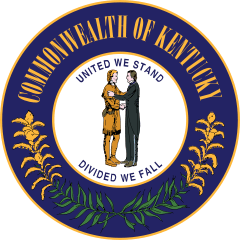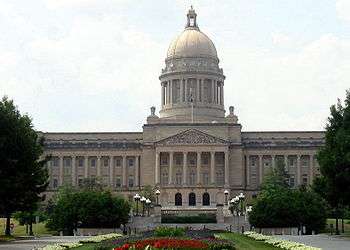Kentucky General Assembly
| Kentucky General Assembly | |
|---|---|
 | |
| Type | |
| Type | |
| Houses |
Senate House of Representatives |
| Leadership | |
Senate Majority Leader | |
House Majority Leader | |
| Structure | |
| Seats | 138 |
Political groups |
Democratic Party Independent Republican Party |
| Elections | |
Last election | November 4, 2014 |
| Meeting place | |
 | |
| Kentucky State Capitol, Frankfort | |
| Website | |
| http://www.lrc.ky.gov/ | |
The Kentucky General Assembly, also called the Kentucky Legislature, is the state legislature of the U.S. state of Kentucky.
The General Assembly meets annually in the state capitol building in Frankfort, Kentucky, convening on the first Tuesday after the first Monday in January. In even-numbered years, sessions may not last more than 60 legislative days, and cannot extend beyond April 15. In odd-numbered years, sessions may not last more than 30 legislative days, and cannot extend beyond March 30. Special sessions may be called by the Governor of Kentucky at any time for any duration.
History
The first meeting of the General Assembly occurred in 1792, shortly after Kentucky was granted statehood. Legislators convened in Lexington, the state's temporary capital. Among the first orders of business was choosing a permanent state capital. In the end, the small town of Frankfort, with their offer to provide a temporary structure to house the legislature and a cache of materials for constructing a permanent edifice, was chosen, and the state's capital has remained there ever since.[1]
After women gained suffrage in Kentucky, Mary Elliott Flanery was elected to the Kentucky House of Representative from the 89th District representing Boyd County, Kentucky. When Flanery took her seat in January 1922, she was the first female state legislator elected in Kentucky and the first female legislator elected south of the Mason–Dixon line.[2]
Operation Boptrot lead to the conviction of more than a dozen legislators between 1992 and 1995. The investigation also led to reform legislation being passed in 1993.[3]
The Civil War
Officially, Kentucky remained neutral during the Civil War. However, the majority of the General Assembly had strong Union sympathies. A group of Confederate sympathizers met in Russellville to establish a Confederate government for the state. The group decided to establish the Confederate state capital in Bowling Green, but never successfully displaced the elected General Assembly in Frankfort.
Assassination of Governor Goebel
The General Assembly played a decisive role in the disputed gubernatorial election of 1900. Initial vote tallies had Republican William S. Taylor leading Democrat William Goebel by a scant 2,383 votes.[4] The General Assembly, however, wielded the final authority in election disputes. With a majority in both houses, the Democrats attempted to invalidate enough votes to give the election to Goebel. During the contentious days that followed, an unidentified assassin shot Goebel as he approached the state capitol.[5]
As Goebel hovered on the brink of death, chaos ensued in Frankfort, and further violence threatened. Taylor, serving as governor pending a final decision on the election, called out the militia and ordered the General Assembly into a special session, not in Frankfort, but in London, Kentucky, a Republican area of the state.[4] The Republican minority naturally heeded the call and headed to London. Democrats predictably resisted the call, many retiring to Louisville instead. Both factions claimed authority, but the Republicans were too few in number to muster a quorum.[5]
Goebel died four days after receiving the fatal shot, and the election was eventually contested to the U.S. Supreme Court, who ruled the General Assembly's actions legal and made Goebel's lieutenant governor, J. C. W. Beckham, governor of the state.[6]
Houses
The General Assembly is bicameral, consisting of a Senate and a House of Representatives.[7] The House and Senate chambers are on opposite ends of the third floor of the capitol building, and legislators have offices in the nearby Capitol Annex building.
Section 33 of the Kentucky Constitution requires that the General Assembly divide the state into 38 Senate and 100 House districts. Districts are required to be as nearly equal in population as possible. Districts can be formed by joining more than one county, but the counties forming a district must be contiguous. Districts must be reviewed every 10 years and be re-divided if necessary.
Under the state constitution, only three counties may be divided to form a Senate district--Jefferson (Louisville), Fayette (Lexington) and Kenton (Covington).
Senate
| Affiliation | Members | |
|---|---|---|
| Republican Party | 27 | |
| Democratic Party | 11 | |
| Vacant seat | 0 | |
| Total | 38 | |
The Senate is the upper house of the General Assembly.
Terms and qualifications
According to Section 32 of the Kentucky Constitution, a state senator must:
- be at least 30 years old;
- be a citizen of Kentucky;
- have resided in the state at least 6 years and the district at least 1 year prior to election.
Under section 30 of the Kentucky Constitution, senators are elected to four year staggered terms, with half the Senate elected every two years.
Leadership
Prior to a 1992 constitutional amendment, the Lieutenant Governor of Kentucky presided over the Senate; the 1992 amendment created a new office of President of the Senate to be held by one of the 38 senators.
- President (elected by full body): Robert Stivers (R-25)
- President Pro-Tempore (elected by full body): David P. Givens (R-9)
Additionally, each party elects a floor leader, whip, and caucus chair.
| Republican Party | Democratic Party | |
|---|---|---|
| Floor Leader | Damon Thayer (R-17) | Ray S. Jones (D-31) |
| Whip | Jimmy Higdon (R-14) | Julian M. Carroll (D-7) |
| Caucus chair | Dan Seum (R-38) | Gerald A. Neal (D-37) |
House of Representatives
| Affiliation | Members | |
|---|---|---|
| Democratic Party | 53 | |
| Republican Party | 47 | |
| Vacant seat | 0 | |
| Total | 100 | |
The House of Representatives is the lower house of the General Assembly. Section 47 of the Kentucky Constitution stipulates that all bills for raising revenue must originate in the House of Representatives.
Terms and qualifications
According to Section 32 of the Kentucky Constitution, a state representative must:
- be at least 24 years old;
- be a citizen of Kentucky
- have resided in the state at least 2 years and the district at least 1 year prior to election.
Per section 30 of the Kentucky Constitution, representatives are elected every two years in the November following a regular session of the General Assembly.
Leadership
- Speaker (elected by full body): Greg Stumbo (D-95)
- Speaker Pro Tempore (elected by full body): Jody Richards (D-46)
Additionally, each party elects a floor leader, whip, and caucus chair.
| Republican Party | Democratic Party | |
|---|---|---|
| Leader | Jeffrey Hoover (R-83) | Rocky Adkins (D-99) |
| Whip | Jim DeCesare (R-17) | Johnny Bell (D-23) |
| Caucus chair | Stan Lee (R-45) | Sannie Overly (D-72) |
Standing committees
Senate Standing Committees and Chairs:
AGRICULTURE, Sen. Paul Hornback
APPROPRIATIONS & REVENUE, Sen. Christian McDaniel
Senate Budget Review Subcommittee on Economic Development and Tourism, Natural Resources and Environmental Protection: Sen. Chris Girdler
Senate Budget Review Subcommittee on Education: Rep. Stephen West
Senate Budget Review Subcommittee on General Government, Finance, and Public Protection: Sen. Danny Carroll
Senate Budget Review Subcommittee on Human Resources: Sen. Ralph Alvarado
Senate Budget Review Subcommittee on Justice and Judiciary: Sen. Wil Schroder
Senate Budget Review Subcommittee on Transportation: Sen. Max Wise
BANKING & INSURANCE, Sen. Tom Buford
COMMITTEE ON COMMITTEES, Sen. Robert Stivers II
ECONOMIC DEVELOPMENT, TOURISM, AND LABOR, Sen. Alice Forgy Kerr
EDUCATION, Sen. Mike Wilson
ENROLLMENT, Sen. Max Wise
HEALTH & WELFARE, Sen. Julie Raque Adams
JUDICIARY, Sen. Whitney Westerfield
LICENSING, OCCUPATIONS, & ADMINISTRATIVE REGULATIONS, Sen. John Schickel
NATURAL RESOURCES & ENERGY, Sen. Jared Carpenter
RULES, Sen. Robert Stivers II
STATE & LOCAL GOVERNMENT, Sen. Joe Bowen
TRANSPORTATION, Sen. Ernie Harris
VETERANS, MILITARY AFFAIRS, & PUBLIC PROTECTION, Sen. Albert Robinson
House Standing Committees and Chairs:
AGRICULTURE & SMALL BUSINESS, Rep. Tom McKee
APPROPRIATIONS & REVENUE, Rep. Rick Rand
House Budget Review Subcommittee on Economic Development & Tourism, Natural Resources, and Environmental Protection, Rep. Jeffery Donohue
House Budget Review Subcommittee on General Government, Finance, and Public Protection, Rep. Rita Smart
House Budget Review Subcommittee on Human Resources, Rep. Joni Jenkins
House Budget Review Subcommittee on Justice and Judiciary, Rep. Kevin Sinnette
House Budget Review Subcommittee on Postsecondary Education, Rep. Arnold Simpson
House Budget Review Subcommittee on Primary/Secondary Education, Rep. Kelly Flood
House Budget Review Subcommittee on Transportation, Rep. Leslie Combs
BANKING & INSURANCE, Rep. Jeff Greer
COMMITTEE ON COMMITTEES, Rep. Greg Stumbo
ECONOMIC DEVELOPMENT: Rep.Ruth Ann Palumbo
EDUCATION: Rep. Derrick Graham
ELECTIONS, CONST. AMENDMENTS & INTERGOVERNMENTAL AFFAIRS: Rep. Reginald Meeks
ENROLLMENT: Rep. Susan Westrom
HEALTH & WELFARE: Rep. Tom Burch
JUDICIARY: Rep. Darryl T. Owens
LABOR & INDUSTRY: Rep. Rick Nelson
LICENSING & OCCUPATIONS: Rep. Dennis Keene
LOCAL GOVERNMENT: Rep. Steve Riggs
NATURAL RESOURCES & ENVIRONMENT: Rep. Fitz Steele
RULES: Rep. Greg Stumbo
STATE GOVERNMENT: Rep. Brent Yonts
TOURISM DEVELOPMENT & ENERGY: Rep. John Short
TRANSPORTATION: Rep. Hubert Collins
VETERANS, MILITARY AFFAIRS, & PUBLIC SAFETY: Rep. Will Coursey
Legislative Research Commission
The Kentucky General Assembly is served by a 16-member nonpartisan agency called the Legislative Research Commission (LRC). Created in 1948, the LRC provides the General Assembly with staff and research support including committee staffing, bill drafting, oversight of the state budget and educational reform, production of educational materials, maintenance of a reference library and Internet site, and the preparation and printing of research reports, informational bulletins and a legislative newspaper. It is led by the elected leadership of the Democratic and Republican parties in both the Kentucky House of Representatives and the Kentucky Senate, while the agency is run on a day-to-day basis by a Director.[12] The current Director of the Legislative Research Commission is David Byerman.
See also
- Kentucky Senate
- Kentucky House of Representatives
- Government of Kentucky
- American Legislative Exchange Council members
References
- ↑ Klotter, James. "The General Assembly: Its History, Its Homes, Its Functions". Kentucky Legislative Research Commission. Retrieved Dec 26, 2013.
- ↑ Powers, James C. (1992). John E. Kleber, ed. The Kentucky Encyclopedia. Lexington, Kentucky: The University Press of Kentucky. pp. 323–324. ISBN 0-8131-1772-0. Retrieved 11 March 2010.
- ↑ Lowell Hayes Harrison, James C. Klotter (1997). A New History of Kentucky. University Press of Kentucky. p. 422. ISBN 978-0-8131-2008-9.
- 1 2 McQueen, Keven (2001). "William Goebel: Assassinated Governor". Offbeat Kentuckians: Legends to Lunatics. Ill. by Kyle McQueen. Kuttawa, Kentucky: McClanahan Publishing House. ISBN 0-913383-80-5.
- 1 2 Woodson, Urey (1939). The First New Dealer. Louisville, Kentucky: The Standard Press.
- ↑ Klotter, James C. (1977). William Goebel: The Politics of Wrath. Lexington, Kentucky: The University Press of Kentucky. ISBN 0-8131-0240-5.
- ↑ "The Constitution of the Commonwealth of Kentucky: Informational Bulletin No. 59" (PDF). Kentucky Legislative Research Commission. October 2005. Retrieved 2007-10-09.
- ↑ "Senate Members". Kentucky Legislative Research Commission. January 5, 2016. Retrieved December 29, 2015.
- ↑ "Senate Leaders: 2013". Kentucky Legislative Research Commission. January 8, 2013. Retrieved February 11, 2013.
- ↑ "House Members". Kentucky Legislative Research Commission. January 5, 2016. Retrieved December 29, 2015.
- ↑ "House of Representatives Leaders: 2013". Kentucky Legislative Research Commission. January 8, 2013. Retrieved February 11, 2013.
- ↑ "About the Legislative Research Commission". Kentucky Legislative Research Commission. Retrieved 2007-01-09.
External links
- Kentucky Legislature Home Page
- Kentucky Revised Statutes
- Kentucky Educational Television General Assembly page